Final report for FNC21-1309
Project Information
Sumner's Farm LLC maintains an 80 acre farm just north of Hillsboro, MO, in the Sandy Creek watershed. The farm has 40 acres of woods, 40 acres in hay production, and two experimental areas committed to soil management trials. The farm makes large amounts of compost and biochar on site. The experimental areas often incorporate cover crops, and use berms and swales to catch water, limit erosion, and keep the experimental plots from cross-contaminating. The soils in the experimental area are silt loams (Useful and Horse creek).
My 2019 SARE Farmer Rancher grant project explored crops’ nutrient density as a function of soil management. An intense, expensive program to restore trace elements and soil organic matter unexpectedly decreased nickel content across diverse crops, and decreased several heavy metals in amaranth leaves and seeds, compared to conventional fertilization. Effects on selected nutrient compound densities were muted. Weed control using physical methods was challenging.
Dietary nickel at levels found with conventional fertilizers probably exacerbate Systemic Nickel Allergy Syndrome (SNAS) in a minority of susceptible individuals, and might contribute to other common diseases. Heavy metal exposure obviously should be minimized.
Other SARE-sponsored reports suggest that no-till management allows soil microbiomes to supply major and trace elements to annual crops. Concerns exist that glyphosate (Round Up) and chemical fertilizers injure the soil microbiome. A main hypothesis was that no till strategies could reduce input costs while achieving crop yield and quality comparable to balanced organic amendments: this ecologically sound practice could improve economic viability and social health.
This proposal compared 9 crop species grown in 5 soil and weed management conditions:
- No till with tailored surface fertilizer
- Sheet mulch (no till/market garden) with general purpose surface fertiliser
- Tilled with tailored fertilizer
- Wheat cover crop, tilled, with tailored fertilizer
- Tilled with tailored fertilizer plus early season (pre-planting) glyphosate
The crops included 3 staple crop representatives, Sweet corn (Non-GMO) for maize and other grains, Cowpeas for legumes, and Better Boy Tomatoes for tomatoes and perhaps other Solanaceae. Each fertilizer was applied in two conditions, organic and conventional (NPK). The organic fertilizer was always accompanied by 1/4 to 1/2 inch of rich compost, or a row of compost through sheet mulch. As this is a rapid soil-building management plan, I refer to it as regenerative. Three objectives achieved were (1) measuring glyphosate content and (2) comparing yields on selected crops across the 4 conditions, and (3) comparing elemental composition of all crops as a function of product, soil management, and weed control measure.
Glyphosate and its degradation product, AMPA, were not detected in the three crops tested, suggesting that glyphosate applied for early season weed control generally does not persist to contaminate harvested crops. Most crop yields were higher in regenerative strips than in the corresponding NPK strips, with the exception of cowpeas. The NPK+glyphosate strip was usually particularly impaired, especially for sweet corn and amaranth, although cowpeas and okra tolerated the combination well. Glyphosate rarely affected elemental composition, and almost never in the three staple crops. Regenerative management significantly affected composition by lowering nickel (Ni) broadly; avoiding cadmium (Cd) accumulation in leafy greens, increasing molybdenum (Mo) and zinc (Zn) broadly, and slightly increasing the low iron (Fe) levels in tomatoes and sweet corn.
The no-till attempts did not dominate other strategies, although surface application of rich compost was helpful. Early season glyphosate treatment did not contaminate the fall harvest, but appears to impair soil health. Compost and organic fertilizer counteracted the detrimental effects of glyphosate on soil health: based on other data collected on the farm, I expect that this is mostly or entirely due to the compost, not the organic salt fertilizers. I continue to observe sufficiently large elemental changes in crops to be clinically meaningful, always in favor of regenerative management rather than conventional NPK fertilisation. Leafy greens for human consumption probably should be grown in regenerative soil conditions.
1. Estimate net profit for each crop in the different weed and fertilizer management strategies (no till, sheet mulch, till, till+glyphosate x organic, conventional fertilizer):
There was no dominating strategy. Yields generally varied inversely with input intensity, and crop responses differed across strategies. Market gardens (sheet mulch, in its second year) with rich compost and minimal fertilizer is attractive when practical.
2. Describe how different weed and fertilizer strategies affect:
a. dietary nickel exposure from diverse crops. Weed control methods were irrelevant to nickel, but all conventional fertilisers (general purpose vegetable fertilizer or bulk urea, potassium, and phosphate) increased nickel relative to the regenerative organic strategy.
b. dietary heavy metal exposures from amaranth leaves and seeds. Amaranth leaves were under attack by pigweed flea beetles and were not assayed, being unmarketable. None of the interventions changed amaranth seed accumulation of heavy metals. However, several leafy greens showed much more cadmium accumulation in conventional fertilizers.
3. Quantify dietary glyphosate and aminomethylphosphonic acid (AMPA) exposure following use for weed control. Glyphosate and AMPA levels in harvested crops were not detectable.
4. Share results in peer reviewed professional publications, conferences, a site tour, and social media. Site tours and one Youtube video have been produced so far. I still expect to publish in peer-reviewed literature and to produce additional videos based on these data.
Research
The experimental area comprised 5 strips, each having two halves that have been similarly managed except for soil amendments. We divided each of the ten 60’x~20’ half-strips into five summer plot partitions for individual USA or global staple crops (amaranth, sweet corn, cowpeas, okra, and opportunistically, tomato), after collecting spring crop samples of radishes, peas, beets, and spinach.
Strips 4b and 4c were densely planted with a cover crop of winter wheat in the fall of 2020. This was cut in the spring or 2021, allowed to dry, and tilled.
Five ounces of 41% generic glyphosate was mixed into 2 gallons of rain water and sprayed on strips 5b ("balanced", regenerative) and 5c ("conventional" or "commercial") on March 29, prior to spring crop planting, and again on June 18, 2021, prior to summer crop planting. The second application used hard water without ammonium sulfate. The soil was tilled to 4-6" in mid-April. Spraying was effective against most weeds with the exception of nutsedge, which eventually was removed manually. Summer crops were harvested between August and October, 2021. Only summer crops were assessed for glyphosate and its primary degradation product, AMPA. These compounds required fairly large samples to assay at the laboratory we used. We anticipated assaying corn and cowpeas in triplicate, but some glyphosate-NPK yields were too low to submit replicate samples. As an alternative evaluation strategy, I sent one pair of samples (from strips 5b and 5c) for each of three crops (sweet corn, cowpeas, and okra) for glyphosate and AMPA assays.
I fertilized strips 1b, 2b, 4b, and 5b using Organicalc(TM) recommendations, and 1c, 2c, 4c, and 5c using conventional Extension guidance, adapted to the weed management plan. I originally planned to provide episodic partial fertilization in strip 2, comparable to strip 1, but instead treated the strip with a full dose of fertilizer, making it a cover-crop-free comparator for strip 4 rather than an equally fertilized comparator for strip 1, but losing the opportunity to distinguish the effects of no-till versus fertilization intensity and timing.
Organicalc recommendations included compost (adjusted for NPK), CalPhos or soft rock phosphate, gypsum or elemental sulfur, Biomin copper or copper sulfate, Borax, sodium molybdate dihydrate, cobalt sulfate heptahydrate, and AZOMITE. Crop specific University of Missouri extension recommendations included only lime and NPK, and never recommended zinc or sulfur amendments.
Strip 3c, the market garden strip with heavy mulch and rows of compost over native soil, was treated with a commercial fertilizer (Fertilome Gardener’s Special 11-15-11) periodically. The paired organic market garden strip 3b was treated with “Complete Organic Fertilizer,” (COF), an alternative to Organicalc recommendations with a recipe developed by the same authors (Steve Solomon & Erika Reinheimer). The COF recipe was tailored by omitting manganese, which Organicalc considers overabundant in the base soil. Given the physical structure of the market garden, soil sampling and tailored fertilisers made less sense than a standardized fertilizer.
Strips 1b & 1c: No till, tailored surface fertilization
Strip 2b & 2c: Till, tailored deep fertilization
Strip 3b & 3c: Sheet mulch, standard surface fertilization of compost filled rows
Strip 4b & 4c: Cover crop, till, tailored deep fertilization
Strip 5b & 5c: Glyphosate, till, spring planting, glyphosate, summer planting; tailored deep fertilization
Burpee's Triple Crown Bicolor Hybrid sweet corn seeds and OK Hatchery Clemson Spineless okra seeds were purchased in 2021. Fifth-generation K112 amaranth seeds grown in 2020 were descendants of a sample obtained from the GRIN seed bank in Ames, Iowa. A neighbor's local farm store had a large excess of "Better Boy" tomato plants that they were giving away. None of my experiments have focused on Solanaceae plants, which are commercially very important. I therefore planted three of these tomato plants in each strip. The conventional side of strip 5 was extremely slow to produce red tomatoes, so some green tomatoes were collected from strips 4 and 5 for comparison. Eventually red tomatoes did mature in strip 5c. Sweet potato production in no-till strips was particularly poor. I opted not to analyze the sweet potatoes and instead analyzed the tomatoes.
Quantitative harvests were obtained for sweet corn, cowpeas, okra, and amaranth. Sweet corn ears were dried and seeds recovered by levering off of the cob. Okra pods were simply counted. Pods between 2 and 5 inches in length were harvested every 2-3 days and dried for other analyses, or sold fresh. Whole cowpea pods and amaranth panicles were harvested and seeds recovered with manual tools.
We submitted expensive glyphosate and AMPA tests only for a single sample each of corn, okra, and amaranth from strip 5.
Five gram samples of dried crops were ground to dust in a coffee grinder, food processor, or blender, depending on the crop. Dried tomatoes required a very fast blender, eg a VitaMix – I was unable to convert dried tomatoes to powder without this machine, and destroyed some cheaper devices trying. Including some samples for other studies and some replicate samples, we sent 484 samples to the Ohio State University Service Testing And Research (STAR) laboratory in November, 2021 for ICP-MS assay of a wide range of elements. Problems with analytic machines and a backlog of samples before our large shipment arrived delayed processing, and our results returned on March 8, 2022.
MANOVA tests were used to evaluate whether sets of dependent element concentration variables were statistically significantly affected by either independent variable, soil management or weed control, after controlling for the crop or product (some crops have multiple products, like roots and leaves). When MANOVA tests indicated a significant effect, ANOVA tests were performed for each element in the set. The staged approach is intended to reduce the occurrence of false positive results due to chance when analyzing so many elements: the MANOVA test is supposed to be conservative, although it also has vulnerabilities. The following sets of elements were analyzed:
Deficient elements = (B, Co, Cu, Mo, S, Se, Zn) = boron, cobalt, copper, molybdenum, sulfur, selenium, zinc, all considered deficient in the soil according to the Organicalc analysis (except Se, which is not addressed), and were repleted using organic salts in the regenerative soil management and COF conditions (Se only in very small amounts in AZOMITE).
Sufficient elements = (Fe, Mg, Mn, Ni, P, K) = iron, magnesium, manganese, nickel, phosphorus, potassium, all major, minor, or trace requirements present in sufficient or excessive amounts in the base soil, or added with intent to provide sufficient amounts in all soil management conditions.
Divalent cations = (Ca, Co, Cu, Fe, Mg, Mn, Mo, Ni, Zn) = calcium, cobalt, copper, iron, magnesium, manganese, molybdenum, nickel, zinc, all required elements with the potential to be present in a +2 oxidation state, although most of these metals have other possible charges. Divalent cations are especially of interest as enzyme cofactors and targets of chelation by glyphosate.
Anions = (P, S, Se) = phosphorus, sulfur, selenium, all found in negatively charged groups, so of some interest in contrast to cations.
Heavy metals = (Sb, As, Cd, Pb) = antimony, arsenic, cadmium, and lead, all toxic at low doses, and not applied except as trace elements in AZOMITE in the regenerative soil management
The formula used for MANOVA was:
Set ~ Product + Soil_mgmnt + Weed_control
Where Set is one of the lists of elements. Product is the marketable part of a specified plant, like Pea Pod, Radish Root, or Radish Leaf. Soil_mgmnt is a member of the set (Regenerative, COF, VegFert, NPK), where VegFert is the Fertilome general purpose vegetable fertilizer. Weed_control is a member of the set (Till, Glyphosate, Mulch, Surface), where Surface indicates a combination of solarization, flame, wheel hoe, hand tool, and manual weed removal, without tillage.
The formula used for ANOVA was
Element ~ Product + Soil_mgmnt + Weed_control
408 samples were collected, dried, and ground during the spring and summer growing seasons and were submitted for elemental analysis in mid November, 2021. We also submitted 78 samples from related pilot and follow-up studies, for a total of 484 samples.
Strip 1b & 1c production was mostly modest to poor. Winter daikon radish and pea crops did well, but daikon radish tubers were mostly above ground. Spring radish and spinach crops were poor. Amaranth is adapted to disturbed ground, which the no-till strip was not, and struggled on both sides. Sweet potatoes also did not grow well at all in strip 1, presumably due to dense ground. Corn, cow peas, and tomatoes were fair, and okra rather poor.
Strip 2b & 2c were both productive.
Strip 3b production was good but 3c was generally better.
Strip 4b & 4c were both productive.
Strip 5b & 5c, which were drenched with the maximum allowed dose of glyphosate, showed dramatic differences. Strip 5c became dry with large cracks in the soil surface, persistent nutsedge, small plants, and low yields, and significantly underperformed comparable strip 4c. Strip 5b was similar to the regenerative strips 2b and 4b, if not more productive.

CROP YIELDS
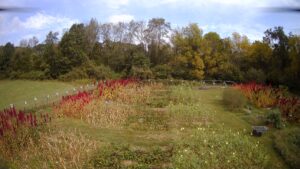
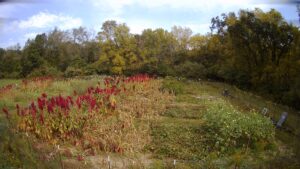
The table presents yields for 4 crops in the 5 pairs of strips. The bold values are indistinguishable maximum values for a crop. The market garden strip provided the highest yield for 3 of the 4 crops.
|
Strip: Description \ Crop |
Sweet corn (maize) dry kernel wt, #/ac (SD) |
Cowpeas, #/ac |
Amaranth seed, #/ac |
Okra, pods/plant |
|
1b: No till, ½ dose Regenerative |
414 (311) |
917 |
1357 |
25 |
|
1c: No till, ½ dose NPK |
685 (170) |
509 |
740 |
7 |
|
2b: Till, Regenerative |
747 (44) |
890 |
2198 |
28 |
|
2c: Till, NPK |
667 (242) |
689 |
1583 |
10 |
|
3b: Market Garden: mulch, “complete organic fertilizer” (COF) |
785 (285) |
1175 |
653 |
16 |
|
3c: Market garden, Commercial garden fertilizer 11-15-11 |
1009 (244) |
727 |
1067 |
73 |
|
4b: Wheat cover crop, till, Regenerative |
858 (159) |
806 |
1,962 |
34 |
|
4c: Wheat cover crop, till, NPK |
529 (220) |
757 |
1,149 |
39 |
|
5b: Glyphosate & till, Regenerative |
578 (182) |
969 |
2,063 |
35 |
|
5c: Glyphosate & till, NPK |
308 (87) |
882 |
661 |
37 |
Sweet corn: The market garden strip (heavy mulch with rows of compost over native soil) treated with a commercial fertilizer (Fertilome Gardener’s Special 11-15-11) yielded the largest amount of dry corn kernels, and 28% more than the paired organic market garden strip treated with “Complete Organic Fertilizer,” (COF). COF is an alternative to Organicalc recommendations, with a recipe developed by the same authors.
In the tilled plots, the regenerative plots (compost plus organic fertilizers and minerals) consistently yielded more corn than the paired NPK-fertilized strips. Regenerative yields in these tilled plots were 10% to 90% higher than the NPK yields.
The no till regenerative plot (1b) and glyphosate plus NPK plot (5c) were the worst performers, with 30-40% of the maximum yield observed in plot 3c.
Cowpeas: In all strips, the regenerative/organic plots yielded more cowpeas than the paired conventionally-fertilized strips. Tilled NPK strips (2c, 4c) yielded the lowest amounts. Glyphosate strips were not impaired. The market garden strip with COF was the best performer, with more than twice the yield of the worst performer (1c, no-till + NPK). Overall, cowpeas have excellent yields assuming that they can be defended from browsing mammals.
Amaranth: K112 amaranth (A. cruentus) yielded about 2,000 pounds per acre in all three tilled regenerative conditions, and was not impaired by glyphosate given that it was planted in a regenerative strip. Yield in the glyphosate-NPK strip was very significantly impaired (-68%), and yield in the other strips was at least 25% lower than in the tilled-regenerative strips.
Okra: Clemson spineless okra, like cowpeas, was productive across a wide range of conditions, but prolific in the market garden with the commercial vegetable fertilizer.
ELEMENTAL ANALYSES
The dataset for the MANOVA and ANOVA analyses had 366 samples, including 38 replicates, leaving 328 independent samples.
Product (P<2x10-16), soil management (P<2x10-16), and weed control (P<5x10-9), all significantly and strongly affected deficient elements according to the MANOVA test, and all three factors were statistically important for products’ boron, copper, molybdenum, and zinc content.
-
Boron was sometimes higher in NPK management (including in sweet corn) and slightly lower with glyphosate and cover-crop-till compared to mulch, till, or surface weed control (P=0.013). Neither effect was seen in cowpeas. Boron is either not an essential nutrient for human nutrition, or is an ultratrace requirement.
-
Copper was sometimes higher with regenerative soil management, but levels were similar in sweet corn, cowpeas, and tomatoes across all soil management strategies. Copper was slightly lower with glyphosate and cover-crop-till compared to till, including in cowpeas and tomatoes but not corn.
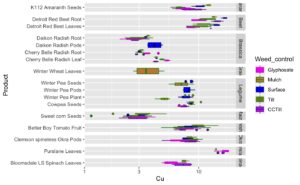
Weed control had little effect on copper levels. -
Molybdenum was frequently highest in the regenerative condition, including in sweet corn and cowpeas. Glyphosate did not have an important effect on molybdenum levels, but concentrations with glyphosate and cover-crop-till were slightly lower than with till.
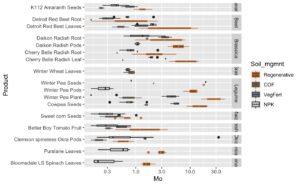
Molybdenum was increased with regenerative management -
Zinc was frequently highest in the regenerative condition, including in sweet corn and tomatoes, but consistent across soil management strategies in cowpeas. Weed control had a significant effect (P=0.0034), again with glyphosate and cover-crop-till having slightly lower zinc levels than till.
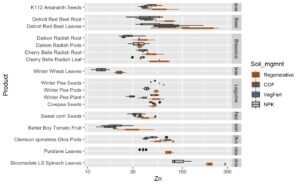
Crops on regenerative soils have higher zinc
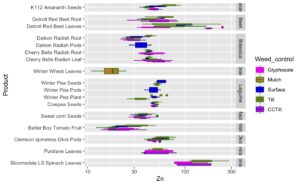
Product (P<2x10-16), soil management (P<2x10-16), and weed control (P<0.003), all significantly affected sufficient elements according to the MANOVA test, although all three factors were statistically important only for products’ nickel content. Weed control was more influential than soil management for magnesium, phosphorus, and potassium.
-
Weed control was most influential for magnesium and nickel levels. Glyphosate and cover-crop-till were associated with slightly depressed values in some crops, but not sweet corn, cowpeas, or tomatoes.
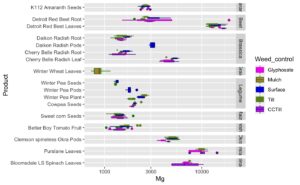
Weed control had little effect on magnesium levels
-
For nickel, surface weed control and tilling were associated with higher levels than glyphosate, mulch, or cover-crop-till. As in previous years, NPK fertilizer was associated with obvious elevations in nickel across many products, relative to regenerative management, including sweet corn and cowpeas. The commercial vegetable fertilizer was associated with the highest nickel levels in sweet corn.
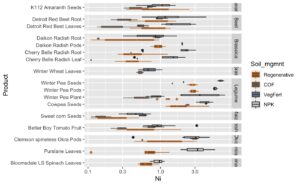
Nickel levels were lower and safer in regenerative strips 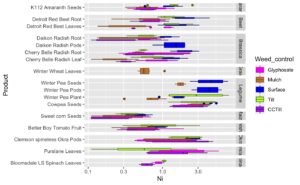
Nickel levels are often higher with tilling or surface weed control compared to glyphosate, cover-crop-till, and mulch. -
Weed control was also a statistically significant predictor of potassium (P<2 x10-16) and phosphorus (P=0.048)levels, more so than soil management, but effects were usually small and were irrelevant for sweet corn and cowpeas.
-
Iron was distinctly higher, but still low compared to other products, in sweet corn and tomatoes from regenerative or COF plots, compared to NPK or vegetable fertilizer. Glyphosate also reduced sweet corn’s already low iron content. Cowpea iron levels were in a narrow range, unaffected by soil management or weed control.
-
For manganese, NPK fertilizer was associated with obvious elevations in content across many products, relative to regenerative management, including cowpeas but not sweet corn. Weed control did not affect manganese levels.
Product (P<2x10-16), soil management (P<2x10-16), and weed control (P=3x10-6), all significantly and strongly affected divalent cations according to the MANOVA test, and all three factors were statistically important for products’ copper, molybdenum, nickel, and zinc content, as already described. Product and soil management were statistically important for iron and manganese content, as already described.
Product (P<2x10-16), soil management (P<7x10-13), and weed control (P=0.00085), significantly affected anions according to the MANOVA test. Product and soil management were statistically important for products’ sulfur content. Sulfur was frequently highest in the regenerative condition, and very slightly reduced by glyphosate in sweet corn and cowpeas. Product and weed control were important for products' phosphorus content, with glyphosate sometimes associated with higher values, including in tomatoes.
Heavy metals were strongly affected by product (P=2 x 10-16), less so by soil management (P=0.001), and unaffected by weed control. The only heavy metal associated with a soil management effect was cadmium, which only accumulated in the NPK condition, and only in leafy green products. Cadmium was always below detection limit in the staple crops.
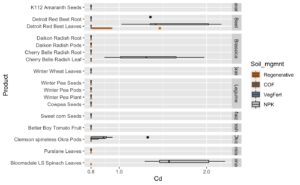
Although not part of the SARE study, a post season soil analysis showed that the organic side of each strip has reached 5% soil organic matter, while the conventional sides are consistently just above 2%. This sampling occurred about 8 months after the last compost application and tilling. Small year-over-year increases in the SOM on the conventional side of each strip might be due to cover crops and debris left on the plots.
Educational & Outreach Activities
Participation Summary:
The farm hosted three harvesting tours in which local farmers and investors got to explore the conventional and organic sides of the different strips, meet unusual crops like amaranth, and take produce home. About 13 people have been involved in these tours including four local farmers, and 1 is collaborating on a follow-up SARE Farmer Rancher Grant application involving livestock.
A group of 14 summer high school students from Lincoln University visited the farm for a field day where we toured regenerative and conventionally managed plots, discussed chemical composition changes, and demonstrated mixing biochar, composts, and ashes in quantities suitable for amending a silt loam soil with pH of 5.
I presented a 1-hour workshop on biochar production to about 60 active and potential homesteaders at a farm in Massachusetts in September, 2022, and discussed various regenerative agriculture concepts.
Two farm professionals have visited the farm and learned about the unexpected nickel results that we are exploring.
I founded a non-profit research and education entity, Argillic Horizon, which has published two videos related to the previous SARE grant on YouTube late in 2021. The short abstract video has had 57 views and the longer, quite detailed video, Eat organic to avoid... Nickel? Wait, what?, which explores the rationale behind the current set of experiments and findings to date, has 74 views. Jennifer Betit Yen, a New York actress who has a blog and a significant dietary nickel sensitivity, added a link to the longer video in her blog. Argillic Horizon will be producing and publishing more videos as new data arrives. A new video on glyphosate is near completion, and should be published on the Argillic Horizon channel soon.
Methods developed at the farm have been shared with refugee and other immigrant families and children in Saint Louis through a local church ministry called Harvest. We have introduced families to amaranth (some already know about it), and perhaps most importantly started introducing them to frost covers and cover crops. Harvest has introduced frost covers to about 20 immigrant high school students and 3 families, and interacts with about a dozen families.
Learning Outcomes
A strong distinction between organic and conventional methods may obscure some hybrid methods that would be extremely effective. Two of these seem likely from our current observations. First, new compost may largely offset soil microbiome or other damage caused by glyphosate. This semi-organic method could be a very useful combination given the substantial difficulty that organic growers face controlling weeds. Second, sheet mulch with conventional fertilizers may be as productive as any fully organic strategy, and more productive than "complete organic fertilizer" with sheet mulch. Again, the decomposing sheet mulch or its microbiome may be able to repair damage caused by urea or other components of conventional fertilizer.
Implications for maize and legumes
For maize varieties that follow the sweet corn pattern, meticulously prepared beds with aging sheet mulch for weed suppression and general purpose vegetable fertilizer may offer a high yield. However, this expensive strategy was associated with nickel levels even higher than seen in corn raised with NPK fertilizer. Yields with tilled regenerative soil management were not much worse, and were associated with at least slight increases in iron, molybdenum, sulfur, and zinc, as well as decreases in nickel, all of which are probably good for most consumers. NPK and glyphosate were associated with lowered yields in this study, and glyphosate with slightly lower iron and sulfur.
For beans and peas that follow the cowpea pattern, meticulously prepared beds with aging sheet mulch for weed suppression and complete organic fertilizer may offer a high yield, but regenerative soil management with or without glyphosate had only modestly lower yields. Regenerative soil management was associated with relatively high molybdenum and sulfur, and low nickel.
Implications for leafy vegetables
A worrisome finding was that multiple leafy spring vegetables accumulated heavy metals when grown in the NPK fertilizer condition, especially cadmium. A diet consisting entirely of foods with a similar cadmium content could be toxic to a consumer. Given that other products did not accumulate cadmium, and that consumers obtain most of their calories directly or indirectly from seeds with very low cadmium content, the levels observed in leaves are not a likely public health threat. Heavy metal exposures are almost completely avoidable with regenerative soil management. Nevertheless, the implication for me is that I should avoid eating or selling leafy greens from the NPK strips, and instead focus on raising root vegetables for their roots or seeds in NPK strips.
Effects of compost versus organic fertilizers
The regenerative program described here combined two distinct interventions. One intervention added a panoply of trace minerals as organically certified salts, approximately as recommended by the Organicalc algorithm in response to Mehlich III soil testing. The other was a rich compost, made largely from imported materials, especially large amounts of spent coffee grounds.
The Organicalc strategy is based on Steve Solomon’s hypothesis that compost made in a closed cycle in a region with known chemical deficiencies (Cascadia) could never correct those deficiencies. Solomon’s personal experience supported this hypothesis. Subsequent reports by people like Gabe Brown suggest that clever biological soil management can release elements that seem to be deficient on soil tests, without importing vast amounts of NPK or other minerals. In fact, regenerative agriculture reports imply that addition of soluble salts as fertilizer will usually be counterproductive, because the plant will use the added salts without nurturing a microbial population that could provide the same elements indefinitely.
By incorporating spent coffee grounds, the compost I use is not from a closed cycle in a nutrient deficient region, but instead continuously adds minerals from diverse tropical, often volcanic soils that support coffee plantations. Starbucks does the hardest work, buying healthy looking seeds, importing them to the Midwest, sterilizing them several times, and grinding 50 pounds a day at the local shop into bite-size particles for worms. Unfortunately, the brewers also extract a large fraction of the water-soluble salts and compounds needed to start a tree seedling, but some of these still remain in the spent coffee grounds.
Furthermore, the large piles of regional deciduous tree leaves and spent coffee grounds without herbicide-laden grass clippings always compost, with the assistance of worms, a few feet from the plots where the compost will be spread. This composting process incorporates features of an indigenous microorganism (IMO) system and vermicompost. The coffee grounds replace the rice or other substrates in a more conventional IMO.
To distinguish the benefits of the rich compost from the comprehensive element repletion, I ran a related experiment on a strip of very poor soil about 100 yards downslope from the strips described in this report. This low fertility experiment had unfenced plots treated with lime as needed and then assigned to NPK, compost, and regenerative (Organicalc) strategies. Amaranth was grown in the first year, and cowpeas, amaranth, sunflowers, and okra in the second year. Wildlife ate the sunflower plants and cowpea pods, but for the surviving okra and amaranth, the compost alone was as productive as the regenerative strategy, and less expensive. In addition, microBiometer assays consistently show microbial activity and fungal fractions that are lowest in NPK, substantially higher in regenerative, and substantially higher still in compost-treated plots. That is to say, the certified organic fertilizer salts are associated with decreased overall and fungal activity, relative to the compost: the compost alone is probably better. Therefore, I expect to start using rich compost alone as my regenerative soil management method.
Project Outcomes
We submitted a follow-up SARE FRG proposal to follow nickel and other metals through the food chain into animals. Also, by focusing on a few crops and selling surpluses, I am getting closer to being able to support human studies: nickel sensitivity with different foods would be a good first topic.